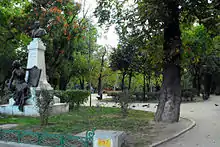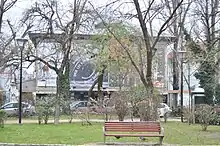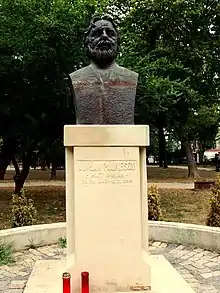Grădina Icoanei
Grădina Icoanei ("Icon's Garden") is a small park in central Bucharest, situated not far away from Piața Romană and Bulevardul Magheru. The park, located next to Gheorghe Cantacuzino Plaza in Sector 2 of the city, was inaugurated in 1873.
| Grădina Icoanei | |
|---|---|
 Statue of George C. Cantacuzino-Râfoveanu at the entrance of the park | |
 Location of the park | |
| Location | Bucharest, Romania |
| Coordinates | 44°26′36.92″N 26°6′14.49″E |
| Area | 2.4 hectares (5.9 acres) |
| Established | 1873 |
| Administered by | Administrația Lacuri, Parcuri și Agrement București |
| Status | Open all year |
| Public transit access | Piața Romană metro station |
| Designers | Karl Kuchnovsky Louis Leyvraz |


The park has a surface area of 2.4 hectares (5.9 acres) and attracts an average of 1,100 visitors on a weekend day.[1] The Bulandra Theatre (the Toma Caragiu stage, Sala Toma Caragiu), Ioanid Park (now called "Ion Voicu"), the Icoanei Church, and the Anglican Church are located in the park's immediate vicinity.
History
In a city plan from 1852, the area occupied now by the park was designated as Maidanul Stăpânirii, signifying a city-owned town square. In the area was the Icoana Pond, from which the Bucureștioara brook sprang, and a wooded grove, which formed the nucleus of the present-day park.[2] The pond, which covered some 20 hectares (49 acres),[3] was drained between 1832 and 1846,[4] during the urban development efforts prompted by General Pavel Kiseleff and the Organic Regulations. The construction of the park was done in 1870–1873, based on plans drawn by the architect Karl Kuchnovsky and approved by Grigore Cerchez, while the landscaping was done by the horticulturist Louis Leyvraz in 1873. At that time, the garden was at the outskirts of the city; it was a place where parties were held, lovers met, and fiddlers sang among the bushes.[5]
At the entrance of the park, a statue of George C. Cantacuzino-Râfoveanu, made by French sculptor Ernest Henri Dubois, was inaugurated in 1904.[2] A female character is at the base of the statue, holding a tablet with her left hand; the feather she was holding in her right hand has since disappeared.[5] In another corner of Grădina Icoanei is the bronze bust of Adrian Păunescu, a poet who lived near the park; the bust, made by the sculptors Ioan Deac-Bistrița and Dragoș Neagoe, was inaugurated in 2012.[6]
References
- Iojă, Cristian I.; Rozylowicz, Laurențiu; Pătroescu, Maria; Niță, Mihai R.; Vânau, Gabriel O. (2011). "Dog walkers' vs. other park visitors' perceptions: The importance of planning sustainable urban parks in Bucharest, Romania". Landscape and Urban Planning. 103 (1): 74–82. doi:10.1016/j.landurbplan.2011.06.002.
- Marinache, Oana (April 13, 2013). "De la Maidanul Stăpânirii la Grădina Icoanei". Adevărul (in Romanian). Retrieved May 23, 2020.
- "Pârâurile pierdute ale Bucureștiului de altădată: Bucureștioara și Dâmbovicioara". bzi.ro (in Romanian). December 30, 2013. Retrieved August 12, 2020.
- Marinescu, Aura (July 8, 2017). "Documentar: Grădini publice de București. Cișmigiu, ridicată pe Lacul lui Dura Neguțătorul, "Maidanul Icoanei", transformat la 1832, iar Botanica are chiparoși bătrâni de 120 de ani". www.news.ro (in Romanian). Retrieved May 23, 2020.
- Cosac, Monica (August 18, 2018). "Grădina Icoanei" (in Romanian). Retrieved August 12, 2020.
- "Bustul lui Adrian Păunescu a fost dezvelit în Grădina Icoanei". Adevărul (in Romanian). May 28, 2012. Retrieved August 11, 2020.
| Wikimedia Commons has media related to Grădina Icoanei. |